DAEWOO DTQ-26S1FS, DTQ-26S1FSP, DTQ-29S1FCN, DTQ-29S1FSN, DTQ-29S1FSP Service Manual
...
Service Manual
Color Television
CHASSIS : CN-200I/A
NTSC-M SYSTEM
MODEL: DTQ-26S1FC/FS/FSP(CN-200I)
DTQ-29S1FCN/FSN/FSP(CN-200I)
DTQ-26S1HC/HS/HSP(CN-200A)
DTQ-29S1HC/HS/HSP(CN-200A)
DAEWOO ELECTRONICS CO., LTD. OVERSEAS SERVICE DEPT.













FEATURES
 FS (Frequency Synthesizer) Tuning System
FS (Frequency Synthesizer) Tuning System
 CATV Ready
CATV Ready
 Monitor Look Design
Monitor Look Design
 A/V IN. (Stereo)
A/V IN. (Stereo)
 Stereo/Mono Function
Stereo/Mono Function
ELECTRICAL SPECIFICATIONS
POWER INPUT |
|
|
FC |
SERIES |
AC 120V 60Hz |
FS |
SERIES |
AC 85V ~ AC 150V 60Hz |
FSP SERIES |
AC 220V 50Hz/60Hz |
|
POWER RATING |
|
|
26” MODELS |
100W |
|
29” MODELS |
105W |
|
INTERMEDIATE FREQUENCIES |
|
|
PICTURE IF CARRIER FREQUENCY |
45.75MHz |
|
SOUND IF CARRIER FREQUENCY |
41.25MHz |
|
COLOR SUB CARRIER FREQUENCY |
42.17MHz |
|
AUDIO OUTPUT RATING |
1.2W 2 |
|
SPEAKER |
2W 8 ohm 2 |
|
ANTENNA INPUT IMPEDANCE |
VHF/UHF 75 ohm UNBALANCED |
|
TUNING RANGES |
|
|
VHF |
|
2 THRU 13 |
UHF |
|
14 THRU 69 |
CATV |
1 THRU 125 |
|
CONTENTS
Safety Precautions |
3 |
Control View |
5 |
Important Service Notes |
7 |
Block Diagram |
8 |
General Adjustments |
10 |
Trouble Shooting Charts |
12 |
Description of Semiconductors |
20 |
Printed Boards |
21 |
Exploded View |
23 |
Schematic Diagram |
25 |
Parts List |
27 |
Option List |
36 |
2
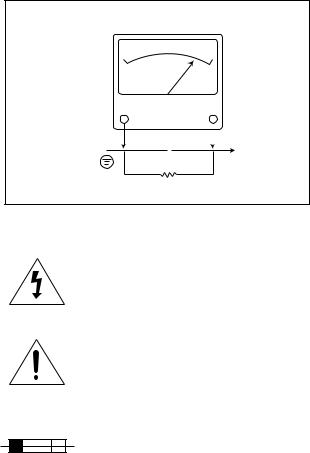
Product safety servicing guidelines for color television receivers
CAUTION : Do not attempt to modify this product in any way. Unauthorized modifications will not only void the warranty, but may lead to your being liable for any resulting property damage or user injury.
Service work should be performed only after you are thoroughly familiar with all of the following safety checks and servicing guidelines. To do otherwise, increases the risk of potential hazards and injury to the user.
SAFETY CHECKS
After the original service problem has been corrected, a check should be made of the following:
SUBJECT : FIRE & SHOCK HAZARD
1.Be sure that all components are positioned in such a way as to avoid possibility of adjacent component shorts. This is especially important on those chassis which are transported to and from the repair shop.
2.Never release a repair unless all protective devices such as insulators, barriers, covers, shields, strain reliefs, and other hardware have been reinstalled per original design.
3.Soldering must be inspected to discover possible cold solder joints, frayed leads, damaged insulation (including A.C. cord), solder splashes or sharp solder points. Be certain to remove all loose foreign particals.
4.Check for physical evidence of damage or deterioration to parts and components, and replace if necessary follow original layout, lead length and dress.
5.No leads or components should touch a receiving tube or a resistor rated at 1 watt or more. Lead tension around protruding metal surfaces must be avoided.
6.All critical components such as fuses, flameproof resistors, capacitors, etc. must be replaced with exact factory types. Do not use replacement components other than those specified or make unrecommended circuit modifications.
7.After re-assembly of the set always perform an A.C. leakage test on all exposed metallic parts of the cabinet, (the channel selector knob, antenna terminals, handle and screws) to be sure the set is safe to operate without danger of electrical shock. Do not use a line isolation transformer during this test. Use an A.C. voltmeter, having 5000 ohms per volt or more sensitivity, in the following manner : connect a 1500 ohm 10 watt resistor, paralleled by a 15 mfd. 150V A.C. type capacitor between a known good earth ground 9water pipe, conduit, etc.) and the exposed metalic parts, one at a time. Measure the A.C. voltage across the combination of 1500 ohm resistor and 0.15 MFD capacitor. Reverse the A.C. plug and repeat A.C. voltage measurements for each exposed metallic part. Voltage measured must not exceed 0.75 volts R.M.S. This corresponds to 0.5 milliamp A.C. Any value exceeding this limit constitutes a potential shock hazard and must be corrected immediately.
A.C. VOLTMETER
Good earth ground, |
|
0.15 F |
|
|
|
||
|
• |
|
|
• |
|
||
such as the water |
|
|
|
|
|||
|
1500 OHM |
|
Place this probe |
||||
pipe, conduit, etc. |
|
|
|||||
|
|
|
|
|
on each exposed |
||
|
|
|
|
|
|
||
10WATT |
metal part. |
|
GRAPHIC SYMBOLS :
The lightning flash with arrowhead symbol, within an equilateral triangle, is intended to alert the service personnel to the presence of uninsulated  dangerous voltage
dangerous voltage that may be of sufficienty magnitude to constitute a risk of electric shock.
that may be of sufficienty magnitude to constitute a risk of electric shock.
The exclamation point within an equilateral triangle is intended to alert the service personnel to the presence of important safety information in service literature.
Fuse symbol is printed on pcb adjacent to the fuse, with  RISK OF FIRE REPLACE FUSE AS MARKED
RISK OF FIRE REPLACE FUSE AS MARKED . The symbol is explained in the service manual with the
. The symbol is explained in the service manual with the
following wording or equivalent.
 CAUTION : FOR CONTINUED PROTECTION AGAINST FIRE HAZARD, REPLACE ONLY WITH SAME TYPE 4A, 125V FUSE
CAUTION : FOR CONTINUED PROTECTION AGAINST FIRE HAZARD, REPLACE ONLY WITH SAME TYPE 4A, 125V FUSE and
and  ATTENTION: AFIN D
ATTENTION: AFIN D ASSU UNE PROTECTION PERMANENTE CONTRE LES RISQUES D
ASSU UNE PROTECTION PERMANENTE CONTRE LES RISQUES D INCENDIE, REMPLACER UNIQUEMENT PAR UN FUSIBLE DE MEME TYPE ET DE 4A, 125V
INCENDIE, REMPLACER UNIQUEMENT PAR UN FUSIBLE DE MEME TYPE ET DE 4A, 125V .
.
SUBJECT : X-RADIATION
1.Be sure procedures and instructions to all service personnel cover the subject of X-rays in current T.V. receivers is the picture tube. However, this tube does not emit X-rays when the high voltage is at the factory specified level. The proper value is given in the applicable schematic. Operation at higher voltages may cause a failure of the picture tube or high voltage supply and, under certain circumstances, may produce radiation in excess of desirable levels.
2.Only factory specified C.R.T. anode connectors must be used. Degaussing shields also serve as X-ray shield in color sets. Always re-install them.
3.It is essential that the serviceman has available an accurate and reliable high voltage meter. The calibration of the meter should be checked perio - dically against a reference standard. Such as the one available at your distributor.
4.When the high voltage circuitry is operating properly there is no possibility of an X-radiation problem. Every time a color chassis is serviced, the brightness should be run up and down while monitoring the high voltage with a meter to be certain that the high voltage does not
3
exceed the specified value and that it is regulating correctly. We suggest that you and your service orgainzation review test procedures so that voltage regulation is always checked as a standard servicing procedure. And that the high voltage reading be recorded on each customer s invoice.
s invoice.
5.When troubleshooting and making test measurements in a receiver with a problem of excessive high voltage, avoid being unnecessarily close to the picture tobe and the high voltage compartment.
Do not operate the chassis longer than is necessary to locate the cause of excessive voltage.
6.Refer to HV, B+and Shutdown adjustment procedures described in the appropriate schematic and diagrams(where used).
SUBJECT : IMPLOSION
1.All direct viewed picture tubes are equipped with an integral implosion protection system, but care should be taken to avoid damage during installation. Avoid scratching the tube. If scratched, replace it.
2.Use only recommended factory replacement tubes.
SUBJECT : TIPS ON PROPER
INSTALLATION
1.Never install any receiver in closed-in recess, cubbyhole or closely fitting shelf space over, or close to heat duct, or in the path of heated air flow.
2.Avoid conditions of high humidity such as : Outdoor patio installations where dew is a factor. Near steam radiators where steam leakage is a factor, etc.
3.Avoid placement where draperies may obstruct rear venting. The customer should also avoid the use of decorative scarves or other coverings which might obstruct ventilation.
4.Wall and shelf mounted installations using a commercial mounting kit, must follow the factory approved mounting instructions. A receiver mounted to a shelf or platform must retain its original feet(or the equivalent thickness in spacers) to provide adequate are flow across the bottom, blots or screws used for fasteners must not touch and parts or wiring. Perform leakage test on customized installations.
5.Caution customers against the mounting of a receiver on sloping shelf or a tilted position, unless the receiver is properly secured.
6.A receiver on a roll-about cart should be stable on its mounting to the cart. Caution the customer on the hazards of trying to roll a cart with small casters across thresholds or deep pile carpets.
7.Caution customers against the use of a cart or stand which has not been listed by underwriters laboratories, inc. For use with their specific model of television receiver or generically approved for use with T.V. s of the same or larger screen size.
s of the same or larger screen size.
4

Product safety servicing guidelines for color television receivers
CAUTION : Do not attempt to modify this product in any way. Unauthorized modifications will not only void the warranty, but may lead to your being liable for any resulting property damage or user injury.
Service work should be performed only after you are thoroughly familiar with all of the following safety checks and servicing guidelines. To do otherwise, increases the risk of potential hazards and injury to the user.
SAFETY CHECKS
After the original service problem has been corrected, a check should be made of the following:
SUBJECT : FIRE & SHOCK HAZARD
1.Be sure that all components are positioned in such a way as to avoid possibility of adjacent component shorts. This is especially important on those chassis which are transported to and from the repair shop.
2.Never release a repair unless all protective devices such as insulators, barriers, covers, shields, strain reliefs, and other hardware have been reinstalled per original design.
3.Soldering must be inspected to discover possible cold solder joints, frayed leads, damaged insulation (including A.C. cord), solder splashes or sharp solder points. Be certain to remove all loose foreign particals.
4.Check for physical evidence of damage or deterioration to parts and components, and replace if necessary follow original layout, lead length and dress.
5.No leads or components should touch a receiving tube or a resistor rated at 1 watt or more. Lead tension around protruding metal surfaces must be avoided.
6.All critical components such as fuses, flameproof resistors, capacitors, etc. must be replaced with exact factory types. Do not use replacement components other than those specified or make unrecommended circuit modifications.
7.After re-assembly of the set always perform an A.C. leakage test on all exposed metallic parts of the cabinet, (the channel selector knob, antenna terminals, handle and screws) to be sure the set is safe to operate without danger of electrical shock. Do not use a line isolation transformer during this test. Use an A.C. voltmeter, having 5000 ohms per volt or more sensitivity, in the following manner : connect a 1500 ohm 10 watt resistor, paralleled by a 15 mfd. 150V A.C. type capacitor between a known good earth ground 9water pipe, conduit, etc.) and the exposed metalic parts, one at a time. Measure the A.C. voltage across the combination of 1500 ohm resistor and 0.15 MFD capacitor. Reverse the A.C. plug and repeat A.C. voltage measurements for each exposed metallic part. Voltage measured must not exceed 0.75 volts R.M.S. This corresponds to 0.5 milliamp A.C. Any value exceeding this limit constitutes a potential shock hazard and must be corrected immediately.
A.C. VOLTMETER
Good earth ground, |
|
0.15 F |
|
|
|
||
|
• |
|
|
• |
|
||
such as the water |
|
|
|
|
|||
|
1500 OHM |
|
Place this probe |
||||
pipe, conduit, etc. |
|
|
|||||
|
|
|
|
|
on each exposed |
||
|
|
|
|
|
|
||
10WATT |
metal part. |
|
GRAPHIC SYMBOLS :
The lightning flash with arrowhead symbol, within an equilateral triangle, is intended to alert the service personnel to the presence of uninsulated  dangerous voltage
dangerous voltage that may be of sufficienty magnitude to constitute a risk of electric shock.
that may be of sufficienty magnitude to constitute a risk of electric shock.
The exclamation point within an equilateral triangle is intended to alert the service personnel to the presence of important safety information in service literature.
Fuse symbol is printed on pcb adjacent to the fuse, with  RISK OF FIRE REPLACE FUSE AS MARKED
RISK OF FIRE REPLACE FUSE AS MARKED . The symbol is explained in the service manual with the
. The symbol is explained in the service manual with the
following wording or equivalent.
 CAUTION : FOR CONTINUED PROTECTION AGAINST FIRE HAZARD, REPLACE ONLY WITH SAME TYPE 4A, 125V FUSE
CAUTION : FOR CONTINUED PROTECTION AGAINST FIRE HAZARD, REPLACE ONLY WITH SAME TYPE 4A, 125V FUSE and
and  ATTENTION: AFIN D
ATTENTION: AFIN D ASSU UNE PROTECTION PERMANENTE CONTRE LES RISQUES D
ASSU UNE PROTECTION PERMANENTE CONTRE LES RISQUES D INCENDIE, REMPLACER UNIQUEMENT PAR UN FUSIBLE DE MEME TYPE ET DE 4A, 125V
INCENDIE, REMPLACER UNIQUEMENT PAR UN FUSIBLE DE MEME TYPE ET DE 4A, 125V .
.
SUBJECT : X-RADIATION
1.Be sure procedures and instructions to all service personnel cover the subject of X-rays in current T.V. receivers is the picture tube. However, this tube does not emit X-rays when the high voltage is at the factory specified level. The proper value is given in the applicable schematic. Operation at higher voltages may cause a failure of the picture tube or high voltage supply and, under certain circumstances, may produce radiation in excess of desirable levels.
2.Only factory specified C.R.T. anode connectors must be used. Degaussing shields also serve as X-ray shield in color sets. Always re-install them.
3.It is essential that the serviceman has available an accurate and reliable high voltage meter. The calibration of the meter should be checked perio - dically against a reference standard. Such as the one available at your distributor.
4.When the high voltage circuitry is operating properly there is no possibility of an X-radiation problem. Every time a color chassis is serviced, the brightness should be run up and down while monitoring the high voltage with a meter to be certain that the high voltage does not
3
exceed the specified value and that it is regulating correctly. We suggest that you and your service orgainzation review test procedures so that voltage regulation is always checked as a standard servicing procedure. And that the high voltage reading be recorded on each customer s invoice.
s invoice.
5.When troubleshooting and making test measurements in a receiver with a problem of excessive high voltage, avoid being unnecessarily close to the picture tobe and the high voltage compartment.
Do not operate the chassis longer than is necessary to locate the cause of excessive voltage.
6.Refer to HV, B+and Shutdown adjustment procedures described in the appropriate schematic and diagrams(where used).
SUBJECT : IMPLOSION
1.All direct viewed picture tubes are equipped with an integral implosion protection system, but care should be taken to avoid damage during installation. Avoid scratching the tube. If scratched, replace it.
2.Use only recommended factory replacement tubes.
SUBJECT : TIPS ON PROPER
INSTALLATION
1.Never install any receiver in closed-in recess, cubbyhole or closely fitting shelf space over, or close to heat duct, or in the path of heated air flow.
2.Avoid conditions of high humidity such as : Outdoor patio installations where dew is a factor. Near steam radiators where steam leakage is a factor, etc.
3.Avoid placement where draperies may obstruct rear venting. The customer should also avoid the use of decorative scarves or other coverings which might obstruct ventilation.
4.Wall and shelf mounted installations using a commercial mounting kit, must follow the factory approved mounting instructions. A receiver mounted to a shelf or platform must retain its original feet(or the equivalent thickness in spacers) to provide adequate are flow across the bottom, blots or screws used for fasteners must not touch and parts or wiring. Perform leakage test on customized installations.
5.Caution customers against the mounting of a receiver on sloping shelf or a tilted position, unless the receiver is properly secured.
6.A receiver on a roll-about cart should be stable on its mounting to the cart. Caution the customer on the hazards of trying to roll a cart with small casters across thresholds or deep pile carpets.
7.Caution customers against the use of a cart or stand which has not been listed by underwriters laboratories, inc. For use with their specific model of television receiver or generically approved for use with T.V. s of the same or larger screen size.
s of the same or larger screen size.
4
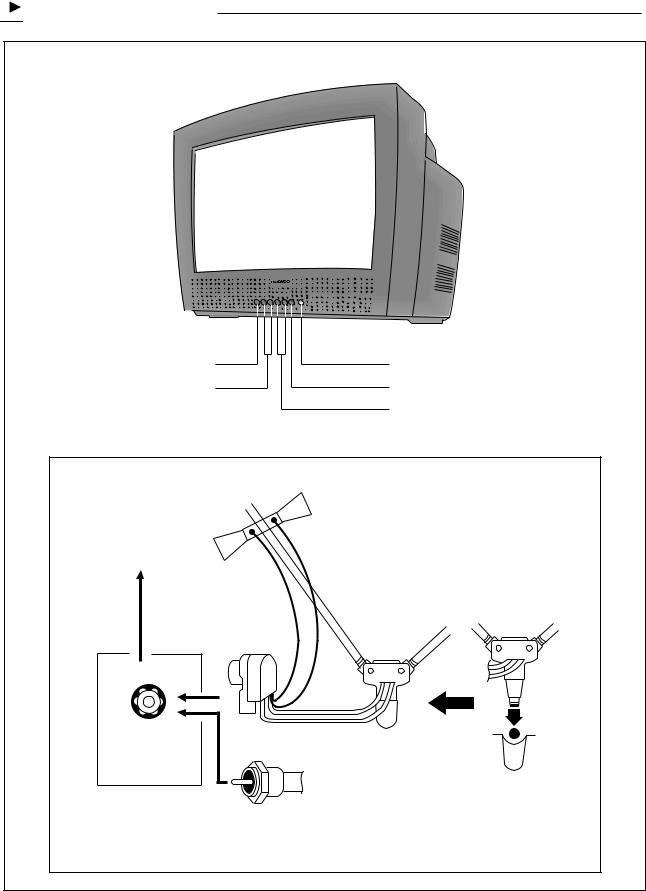

 CONTROL VIEW
CONTROL VIEW
F-CONNECTOR |
300 OHM-75 OHM |
COUPLING |
TRANSFORMER |
VHF |
75Ω |
FROM 75 OHM |
VHF ANTENNA WITH |
CABLE OR CABLE |
TV SYSTEM |
5 |
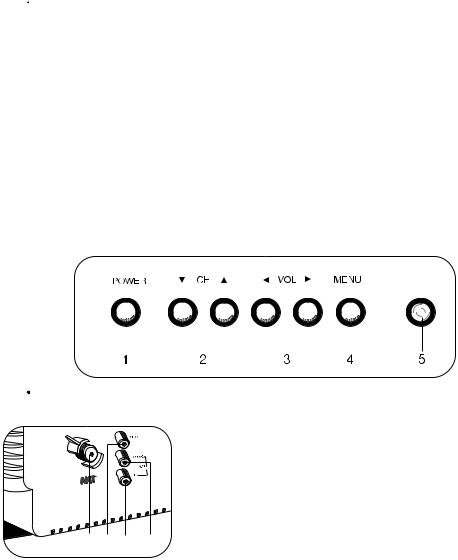
1. Overview of Your Equipment
Your TV comes with a remote control. The section below summarizes the buttons,controls, and terminals that you will use with your TV.
2.Your TV's Front Panel
1.POWER
Use this buttom to turn your TV on or off.
2. CH
CH
Use these buttom to change channels on your TV, or to select items in the menu system.
3.  VOL
VOL 
Use these buttom to change your TV s volume, to activate selections in the menu system, or to change audio and video settings.
s volume, to activate selections in the menu system, or to change audio and video settings.
4.MENU
Use this buttom to turn the TV s menu system on and off.
s menu system on and off.
5.Remote control receiver
This receiver receives a signal from your remote control. Do not block it.
3. Your TV's Back Panel
|
|
|
|
1. |
Antenna terminal |
|
|
|
|
|
Use this terminal to attach an antenna or cable |
|
|
|
|
|
system to your TV. |
|
|
|
|
2. |
VIDEO IN |
|
|
|
|
|
This terminal allows the TV to receive a video |
|
|
|
|
|
signal from another components, such as a VCR. |
1 |
2 |
4 |
3 |
3. |
AUDIO R/MONO IN |
|
This terminal allows the TV to receive an audio |
||||
|
|
|
|
|
|
|
|
|
|
|
R/MONO signal from another components, such as |
|
|
|
|
a |
VCR. |
|
|
|
|
4. |
AUDIO L IN |
|
|
|
|
|
This terminal allows the TV to receive an audio L |
|
|
|
|
|
signal from another components, such as a VCR. |
6
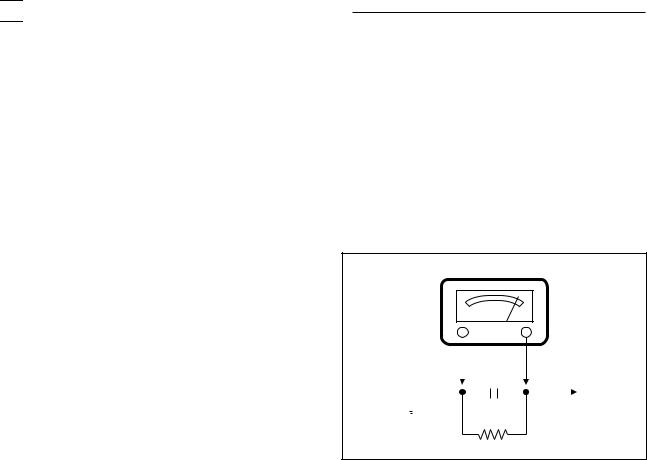

 IMPORTANT SERVICE NOTES
IMPORTANT SERVICE NOTES
1. X-RAY RADIATION PRECAUTION
1)Excessive high voltage can produce potentially hazardous X-RAY RADIATION. To avoid such hazards, the high voltage must not be above the specified limit. The nominal value of the high voltage of this receiver is 27kv at zero beam current (minimum brightness) under a 120V AC power source. The high voltage must not, under any circumstances, exceed 32kv. Each time a receiver requires servicing, the high voltage should be checked following the HIGH VOLTAGE CHECK procedure on page 3 of this manual. It is recommended as a parts of the service record. It is important to use an accurate and reliable high voltage meter.
2)This receiver is equipped with X-RADIATION PROTECTION circuit which prevents the receiver from producing an excessively high voltage even if the B+voltage increases abnormally. Each time the receiver is serviced, X-RADIATION PROTECTION circuit must be checked to determine that the circuit is properly functioning, following the X-RADIATION PROTECTION CIRCUIT CHECK procedure on page 3 of this manual.
3)The only source of X-RAY RADIATION in this TV receiver is the picture tube. For continued X-RAY RADIATION protection, the replacement tube must be exactly the same type tube as specified in the parts list.
4)Some parts in this receiver have special safety-related characteristics for X-RAY RADIATION protection. For continued safety, parts replacement should be undertaken only after referring to the PRODUCT SAFETY NOTICE below.
2. SAFETY PRECAUTION
WARNING : Service should not be attempted by anyone unfamiliar with the necessary precaution on this receiver. The following are the necessary precaution to be observed before servicing.
1)Since the chassis of this receiver has hazardous potential to ground whenever the receiver is plugged in (floating chassis), an isolation transformer must be used during servicing to avoid shock hazard.
2)Always discharge the picture tube anode to the CRT conductive coating the picture tube. The picture tube is highly evacuated and if broken, glass fragments will be violently expelled. Use shatterproof goggles and keep picture tube away from the body while handling.
3)When placing chassis in the cabinet, always be certain that all the protective devices are put back in place,
such as; nonmetallic control knobs, insulating covers, shields, isolation resistor-capacitor network, etc.
4)Before returning the set to the customer, always perform an AC leakage current check on the exposed metallic parts of the cabinet, such as antennas, terminals, screw-heads, metal overlays, control shafts etc. to be sure the set is safe to operate without danger of electrical shock. Plug the AC line cord
directly into a 120V AC outlet (do not use a line isola-  Minimum brightness
Minimum brightness
tion transformer during this check). Use an AC voltmeter having 5000 ohms per volt or more sensitivity in the following manner.
Connect at 1500 ohm 10 watt resistor, paralleled by a 0.15 mfd. AC type capacitor, between a known good earth ground (water pipe, conduit etc.) and the exposed metallic parts, one at a time. Measure the AC voltage across the combination of 1500 ohm resistor and 0.15 mfd capacitor. Voltage measured must not exceed 0.3 volts RMS. This corresponds to 0.2 millliamp. AC. Any value exceeding the limit constitutes a potential shock hazard and must be corrected immediately.
AC VOLT METER
|
|
|
|
|
|
|
|
0.15MFD |
|
|
|||
|
|
|
|
|
|
|
|
|
|
||||
|
|
|
|
|
|
|
|
|
|
|
|
|
|
|
|
|
|
|
|
|
|
|
|
|
|
|
|
|
|
|
|
|
|
|
|
|
|
|
Place this probe |
||
|
|
|
|
|
|
|
|
1500 ohm |
|||||
|
|
|
|
|
|
|
|
||||||
|
|
|
|
|
|
|
|
on each exposed |
|||||
Good earth ground |
10watt |
||||||||||||
|
|
||||||||||||
such as d water |
metallic part. |
|
|
pipe, conduit, etc. |
|
3. PRODUCT SAFETY NOTICE
Many electrical and mechanical parts in this chassis have special safety-related characteristics. These characteristics are often passed unnoticed by a visual inspection and the protection afforded by them cannot necessarily be obtained by using replacement components rated for higher voltage, wattage, etc. Replacement parts which have these special safety characteristics are identified in this manual and its supplements; electrical components having such features are identified by shading on the schematic diagram and the parts list.
Before replacing any of these components, read the parts list in this manual carefully. The use of substitute replacement parts which do not have the same safety characteristics as specified in the parts list may create X- ray radiation or other hazards.
4. SERVICE NOTES
1)When replacing parts or circuit boards, clamp or bend the lead wires to terminals before soldering.
2)When replacing a high wattage resistor (metal oxide film resistor) in the circuit board, keep the resistor min 1/2 inch away form circuit board.
3)Keep wires away from high voltage or high temperature components.
7
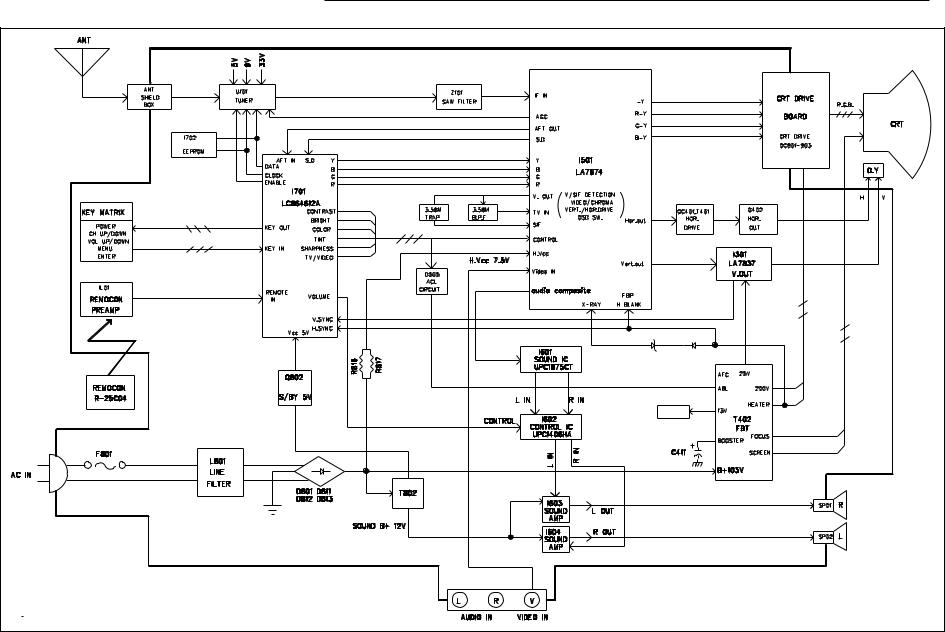
 BLOCK DIAGRAM (CN-200I)
BLOCK DIAGRAM (CN-200I)
8 |
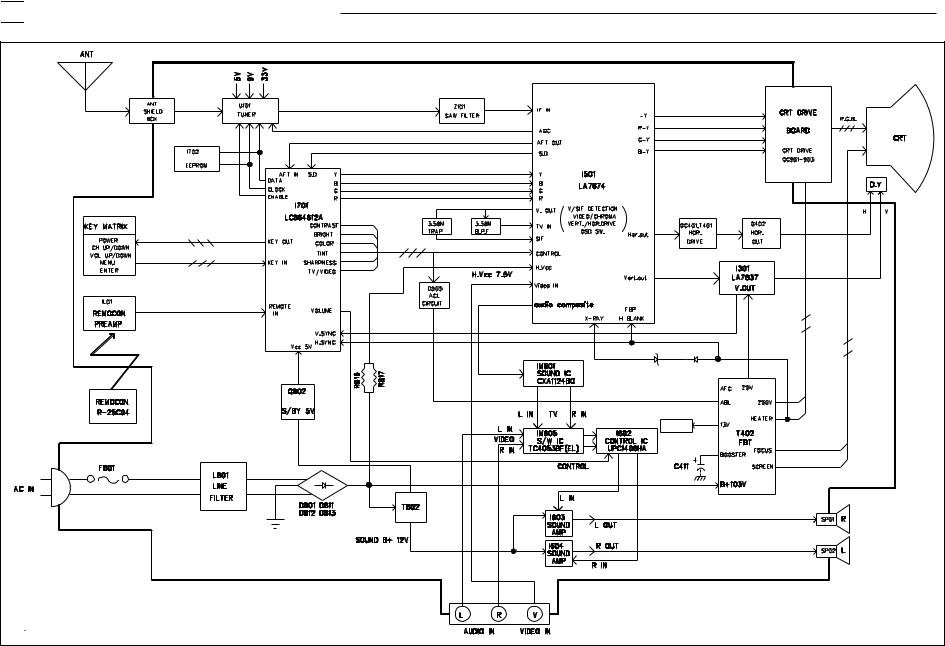

 BLOCK DIAGRAM (CN-200A)
BLOCK DIAGRAM (CN-200A)
9 |


 GENERAL ADJUSTMENTS
GENERAL ADJUSTMENTS
1. GENERAL
In the majority of cases, all color televisions will need only slight touch-up adjustment upon installation. Check the basic characteristics such as height, focus and subbasic characteristics such as height, focus and subbright. Observe the picture for good black and white details without objectionable color shading.
2. VERTICAL HEIGHT ADJUSTMENT
1)Tune in an active channel.
2)Adjust brightness and contrast controls for a good picture.
3)Adjust vertical height control (R305) for approximately one half inch over scan at top and bottom of picture screen.
4)Vertical centering adjustment R310 Horizontal centering adjustment R516.
3. FOCUS ADJUSTMENT
1)Tune in an active channel.
2)Adjust brightness, sharpness and contrast controls for a good picture.
3)Adjust focus control (part of T402) for sharp scanning lines and/or sharp picture.
4. RF AGC ADJUSTMENT
1)Tune in an active channel.
2)Using the attenuator, apply the signal of 60dBm to the antenna input terminal.
3)Turn RF AGC control (R113) full clockwise until snow or/and noise appears in the picture, then slowly turn control counter clockwise until snow or/and noise disappears.
5. HIGH VOLTAGE CHECK
High voltage is not adjustable but must be checked to verify that the receiver is operating within safe and efficient design limitations as specified:
1)Operate Receiver for at least 15 minutes at 120V AC line.
2)Set brightness sharpness, contrast and color control to minumum position (Zero beam).
3)Connect accurate high voltage meter to CRT anode. The reading should be 26kv~28kv
If a correct reading cannot be obtained, check circuity for malfunctioning components.
6. X-RADIATION PROTECTION CIRCUIT TEST
When service has been performed on the horizontal deflection system, high voltage system or B+system, the X- RADIATION protection circuit must be tested for proper operation as follows:
1)Operate receiver for at least 15 minutes at 120V AC line.
2)Adjust all customer controls for normal picture and sound.
3)Short R414(X-RAY Short test), and remove short clip.
4)If the operation of horizontal osc. does not stop in step The circuit must be repaired, before the set is returned to the customer.
7. CRT GRAY SCALE ADJUSTMENT
1)Tune in an active channel.
2)Set the COLOR control to minimum.
3)Turn the SCREEN control (on T402 fully counter-
clockwise.)
4)Rotate the RED, GREEN and BLUE BIAS controls (R917, R918, R919) counterclock wise from the maximum, set them to the position where notches in the knobs become parallel to the surface of P.C. Board.
5)Set the GREEN and BLUE DRIVE controls (R920, R921) to the mid position.
6)Turn the service switch SW901 (Service Position) on the CRT board.
7)Rotate the SCREEN control (on T402) gradually clockwise until the second horizontl line following the first line appears slightly on the screen. Then turn fully counterclockwise the two BIAS controls corresponding to the colors of the first and the second horizontal lines to eliminated the lines.
8)Set the SCREEN control to the position where the third horizontal line lights slightly on the screen.
9)Adjust the two BIAS control set to the minimum in item 7) above to obtain the slightly lighted horizontal line in the same levels of three (red, green, blue) colors. (The line should be white if the BIAS controls are adjusted properly.)
10)Turn the service switch SW901 again (Normal position on the CRT board.)
11)Press PICTURE-SEL, P-UP and set the brightness and contrast controls to the maximum.
12)Adjust the BLUE and GREEN DRIVE control to obtain proper white-blanced picture in high light areas.
13)Using P-SEL, P-DN key, set the brightness and contrast controls to obtain dark gray raster. Then check the white balance in low brightness. Of the white balance is not proper, retouch the BIAS controls and DRIVE controls to obtain a good white balance in both low and high light areas.
8. MAIN B+(103V) ADJUSTMENT
1)Tune in an active channel
2)Check TP10 (DC 103V Line) using D.V.M
3)Adjust voltage control (R809) for main B+(DC 103V)
9. SUB-BRIGHTNESS ADJUSTMENT
1)Tune in a color program.
2)Set the CONTRAST control to maximum and the BRIGHTNESS control to maximum and the SHARPNESS control to the center position.
3)Set the COLOR and TINT controls to center.
4)Set the SUB-BRIGHT control R522 to center and leave the receiver on five minutes in this state.
5)Watching the picture carefully, adjust the SUBBRIGHT control in the position where the picture does not show evidence of blooming in high brightness area and not appear too dark in low bright area.
6)Check for BRIGHTNESS controls at both extremes.
7)If the picture does not appear dark with the CONTRAST and BRIGHTNESS control turned to minimum, or not appear bright with the controls turned to maximum, adjust the SUB-BRIGHT control again for an acceptable picture.
10
